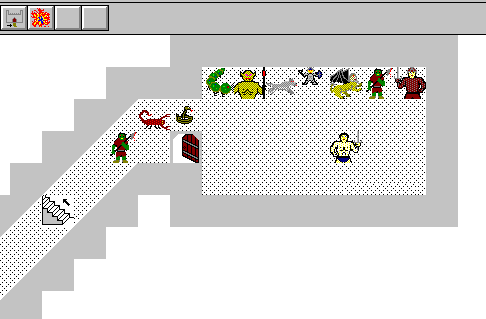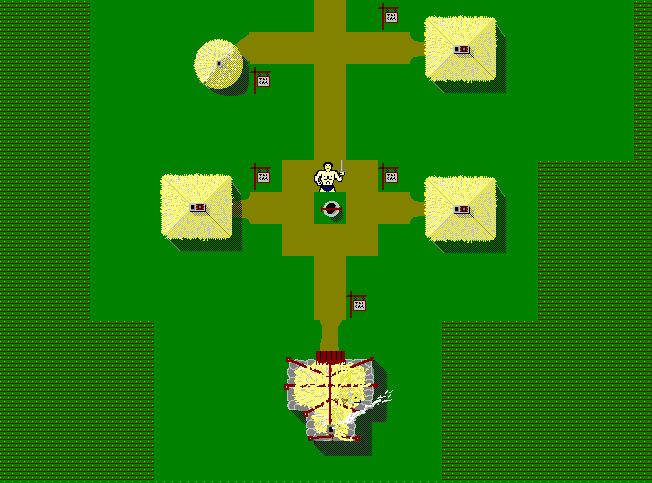
Created by Rick Saada and released as shareware by Epic-Megagames, Castle of the Winds is an entertaining graphics Roguelike role-playing game.
Two episodes make up the game; the first is called “A Question of Vengeance” and is available as shareware. “Lifthransir’s Bane” is the second, and it costs $25 to register. Like previous Roguelike games, the game is played top-down and has a single, massive dungeon that is 25 levels deep.
In the first episode, you have to find an old helm so you can take the kingdom that is rightly yours by birth. Your way is blocked by the formidable demon lord Surtur. Like other roguelikes, this one has the same gameplay. You find treasures and strong magical equipment that will aid you in your fight against the demon as you explore dungeons, avoid or disarm traps, and battle creatures.
Although a little corny, the game’s graphics are decent for a roguelike. The gameplay itself is intricate and captivating. There are many monsters to defeat and hundreds of spells and weapons to employ. Castle of the Winds is enjoyable, simple to use, and less complicated than NetHack or ADOM, despite this.
This “lite” shareware game, just made available to the public domain by its creator, is suitable for fans of Roguelikes. Strongly advised!
Created by Rick Saada and published by Epic MegaGames in 1993, Castle of the Winds is a roguelike fantasy role-playing game for Windows 3.1. It’s the first installment of a well-known series and among the best-selling games ever made for Windows 3.x The series was first published as shareware, but in 1998 the author declared it freeware.

Saada was a member of a Microsoft team that worked only on DOS, although he believed Windows was the way of the future. To put his love of video games into practice, he decided to study Windows program development. Saada decided against designing a DOS game with VGA visuals in favor of designing a game that was completely integrated with the Windows 3.x operating system, utilizing native mouse-controlled UI elements and the 16 system colors by default. As a result, the game has an intriguing gameplay mechanic despite perhaps not having the most striking graphics. There will be a lot of emphasis on magic and spells, along with things that can be renamed, cursed, or enchanted. One of the best things about this game—possibly even better than the others—is how highly replayable every element is, just as in Diablo.
One of the greatest pleasures of discovering the internet for the first time is learning that the obscure PC games you played as a kid, but that none of your friends had ever heard of, were much more popular than you realized. This is a list that gets smaller and smaller every day that Twitter is around. The only way to gauge how popular a game is when you’re young and blissfully ignorant is to see how much other people are talking about it. Since only two other students in my grade owned a Game Boy, I grew up with the false impression that every game I ever played, from Kirby’s Dream Land to Jazz Jackrabbit, was the pinnacle of obscurity.

Looking back, I think these games ended up in three different categories of obscurity. First of all, games that aren’t at all obscure, like Age of Empires and Commander Keen, are appreciated by a lot more people than just me, as I learned from a young age. Other games include Big Red Racing, SimTower, possibly the whole Sierra city-building series (Caesar 3, Pharaoh, Zeus), Shareware titles like Boogaloopers or Blades of Exile, and others that are neither obscure nor particularly well-known. I find it difficult to think of instances because I played most of these games on the old “200 Games on one CD!” compilations, most of which were Shareware demonstrations, simple Sokoban puzzles, or simple variations of Mahjong, Solitaire, and Reversi.
Then there are the games that, regrettably, leave behind so little evidence that it’s difficult to say if they ever existed at all. The 3D platformer game Best Friends features Petey and Patty the penguin. Numerous “edutainment” games from Dorling Kindersley, such as Stowaway and My First Amazing World Explorer, recognized the value of including a game in your educational program. A basic golf game called Gopher Golf is played using gophers. I would like to inform you that there existed an MS-DOS platformer called Pickle Wars, but I can’t be positive that it wasn’t a fever dream or the product of my hyperactive mind. It’s funny that Pickle Wars has a Wikipedia page, yet these are the games where you would be shocked to learn that it existed. It’s finally true, and I can tell my therapist so.
